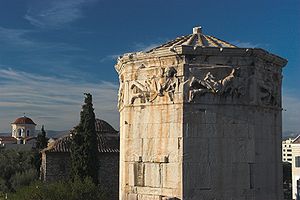
Andronicus of Cyrrhus
Encyclopedia

Cyrrhus
Cyrrhus, or Kyrros was a city in ancient Syria founded by Seleucus Nicator, one of Alexander the Great's generals. Other names for the city include Hagioupolis, Nebi Huri نبي حوري, Khoros . Its ruins are located in northern Syria, near the Turkish border. It lies about 70 km northwest of Aleppo...
(Greek
Ancient Greek
Ancient Greek is the stage of the Greek language in the periods spanning the times c. 9th–6th centuries BC, , c. 5th–4th centuries BC , and the c. 3rd century BC – 6th century AD of ancient Greece and the ancient world; being predated in the 2nd millennium BC by Mycenaean Greek...
:Ανδρόνικος Κυρρήστου) or Andronicus Cyrrhestes,son of Hermias, was a Greek
Greece
Greece , officially the Hellenic Republic , and historically Hellas or the Republic of Greece in English, is a country in southeastern Europe....
astronomer
Astronomer
An astronomer is a scientist who studies celestial bodies such as planets, stars and galaxies.Historically, astronomy was more concerned with the classification and description of phenomena in the sky, while astrophysics attempted to explain these phenomena and the differences between them using...
who flourished about 100 BC.
He built a horologion
Horologion
The 'Horologion' , or Book of Hours, provides the fixed portions of the Daily Cycle of services as used by the Eastern Orthodox and Eastern Catholic churches...
at Athens
Athens
Athens , is the capital and largest city of Greece. Athens dominates the Attica region and is one of the world's oldest cities, as its recorded history spans around 3,400 years. Classical Athens was a powerful city-state...
, the so-called Tower of the Winds
Tower of the Winds
The Tower of the Winds, also called horologion , is an octagonal Pentelic marble clocktower on the Roman agora in Athens. The structure features a combination of sundials, a water clock and a wind vane...
, a considerable portion of which still exists. It is octagonal, with figures carved on each side, representing the eight principal winds. In antiquity a bronze figure of Triton on the summit, with a rod in his hand, turned round by the wind, pointed to the quarter from which it blew. From this model is derived the custom of placing weathercocks on steeples.

